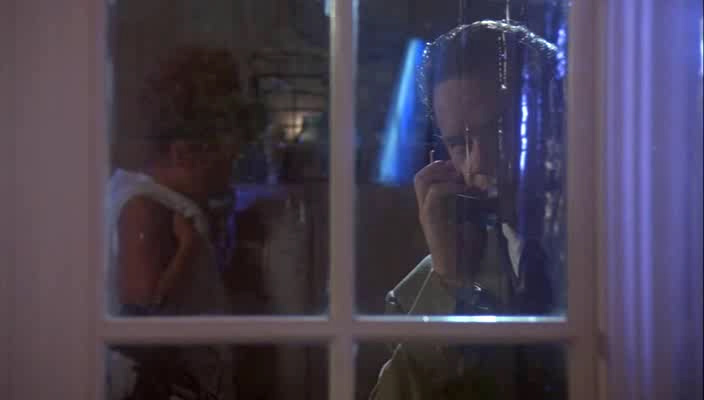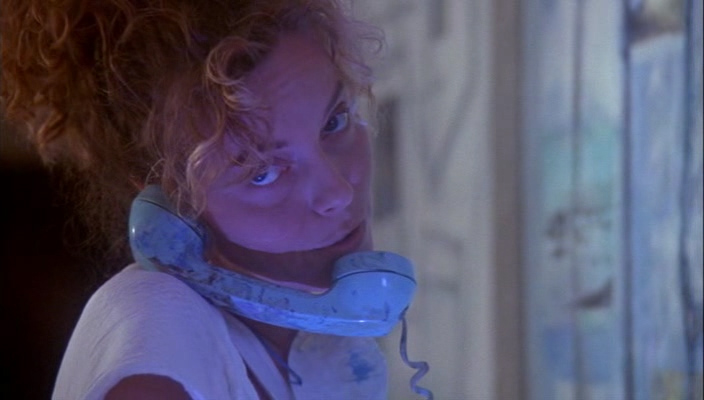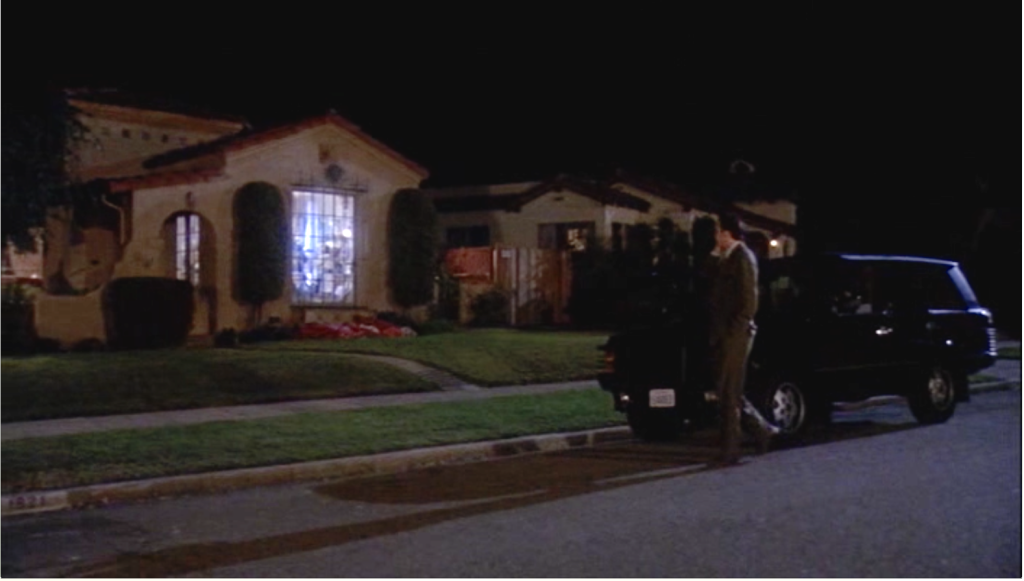The Player (Robert Altman, 1992)
Michel Chion
(Translated by Alyssa Beaton)
The scene that I have chosen from Robert Altman’s film The Player (adapted from Michael Tolkin’s novel of the same name, who also wrote the screenplay) presents an ideal example of a scene, which, in order to be understood, needs to be contextualized within both cultural history and the history of cinema. Just like an eighteenth century painting, if one seeks to truly analyze the work, and not simply enjoy the painting based on personal interest and opinion, it must be situated at once within art history, and the greater history of the period. Altman’s film dates back only so far as 1992, yet so much has happened over the past twenty years!
Firstly, to situate the film within its cultural context: the ownership and use of mobile phones in the pre-Internet era were restricted to the affluent, serving as a symbol of their power. Six to seven years later, this would no longer be the case. Therefore, when we see Griffin Mill (Tim Robbins) call June Gudmundsdottir (Greta Scacchi) from his mobile phone, as he watches her through the window (he is in the street, free to move around, while she stands clearly visible in her home, cradling a corded phone on her shoulder), June couldn’t have imagined that—at this moment in history—Griffin was calling her from anywhere in the world, let alone that he was standing outside her door wielding a symbol of ease and power.
Secondly, to consider the film within the history of cinema: the telephone in cinema has long been associated with terror and harassment, particularly as it affects women. In early silent thrillers, distressed wives phone their husbands for help from an isolated home (The Lonely Villa, D.W. Griffith, 1909; Suspense, Phillips Smalley and Lois Weber, 1913). Later, in films best represented by When A Stranger Calls (Fred Walton, 1979), the telephone becomes an instrument used by anonymous perverts and murderers to terrorize women (as in Sorry, Wrong Number, 1948, directed by Anatole Litvak, or Alfred Hitchcock’s Dial M. for Murder, 1954). It’s interesting to note that several of these films were adapted from the theatre, particularly André de Lorde’s popular French melodrama Au téléphone (1901). The play, in this regard, is somewhat of a paradox, as de Lorde’s pieces largely conformed to the naturalist aesthetic of the period, and respected the unity of the space, whereas the cinema permits numerous points of view and allows for the distance between the speakers to be represented by either alternating shots or via split-screen. Therefore, when a film respects a single point of view, the bias is not theatrical, but cinematic as it pushes past the simple spatial solutions that the cinema allows. However, we will soon understand how the notion of “point of view” is actually quite complex.
Of course, it is the trope of the terrorized, single woman harassed over the telephone—successfully revived in Wes Craven’s popular Scream (1997), and the sequels and imitations which followed it, each updated with the capabilities of contemporary telephone technology—that this sequence references. Yet the reference is made to invert the relation of power. Here, the woman is at ease, as she explains to Griffin how her partner David Kahane refers to him as “the Dead Man.” Rather than a predator, Griffin resembles an unthreatening, roaming ghost-like figure, circling around June’s warmly lit home. His passive role in this sequence is in contradiction to his social and technological “superiority,” made visibly manifest in his use of a mobile telephone.
Just as in Alfred Hitchcock’s Rear Window (1954), when Griffin makes a phone call we hear at once 1) up close, the dial tone of the phone as it is pressed against Griffin’s ear and 2) at a distance, June’s telephone ringing from inside her house. The experience of hearing two fundamentally different sounds that bear the same meaning—one meant for individual audition, and the other amplified to alert people within earshot—could have been represented in the 1950s if a character phoned their neighbour. Although this was rarely done when representing a phone call in a public, outdoor space.
Within the fictional world of the film (what I call the “diegetic reality”), June has no reason to be alarmed by this phone call—the man on the other end of the phone is speaking normally, giving no audible indication of being a potential threat (such as heavy breathing or cryptic phrasing). In this case, it is the spectator who, considering how scenarios like this usually develop, assumes danger may be imminent: a darkened house on a deserted street, a woman painting carelessly in full view from the windows, and a man on the prowl. Of course, Thomas Newman’s unsettling score accompanying Griffin Mill’s drive out to confront David Kahane equally informs this assumption. All elements combined, the scene initially invokes the classic scenario of a woman in danger.
At this point, I’ve referenced two of the three terms that I developed in previous work for film analysis: cinematic reality, diegetic reality and pro-filmic reality. The events and actions that affect characters in the fictional world of the film are referred to as the “diegetic reality.” The “cinematic reality” is what the spectator sees and hears, and the “pro-filmic reality” refers to the world as we know it, surrounding the production of the film. Beyond the (de)emphasis of Tim Robbins’ exceptional height, the latter does not figure prominently. Tim Robbins’ height, measuring a towering 6’5”, is used throughout the film, as Altman at once emphasizes his height by putting him in confrontation with shorter characters, and at other times, as in this scene, minimizes his height using set design to match June’s height: Griffin Mill stands outside, whereas June is in the house where the floor is raised.
For my analysis, I will principally refer to the first two notions, the diegetic and cinematic realities.
The construction of conventional telephone conversation scenes (a typology for which I developed in Film, A Sound Art) represents the intersection of these two realities. Should a film present two characters living in different places, the alternating montage of shot reverse shot permits the depiction of their shared conversation, as these distant bodies are brought together within the cinematic reality (character A looks right towards character B, whose face is angled left). [1] Diegetic reality dictates that the characters can’t actually see one another, yet this phenomenon of corresponding looks, a posture typically reserved for face-to-face interactions, evokes a sense that they are brought together within the cinematic reality (note that the placement and direction of the actors is a product of the cinematic reality). The magic of cinema relies on the ability to seamlessly bring together both diegetic and cinematic realities. They are defined and showcased by one another, as if through a subtle dialogue: either they contradict or reinforce one another, or go so far as to suggest two distinct realities (one physical and material, the other symbolic).
In this sequence from The Player, the spectator is caught in a mix of conversations. From a visual point of view, with two exceptions that will be further discussed below, the camera stays outside and remains aligned with Griffin’s point of view—he sees her, but she doesn’t know where he is nor from where he is calling. For her, he’s an acousmatic voice (no visual source), whereas he can see her—just as we do—and know that she’s talking to him while she continues painting. Alfred Hitchcock’s Rear Window features a similar scenario, wherein Jeff Jeffries (James Stewart), playing the hero, torments Lars Thorwald (Raymond Burr) over the telephone, watching him from across their shared courtyard.
From a sonic point of view, Altman equally inverts the usual acoustics of the “stalking man” scene: in this case, we hear Griffin’s voice clearly, while June’s voice is the one that is cold and distant, filtered through the telephone—even as the camera films Griffin from inside June’s house. The editing suggests, therefore, that June could have seen Griffin through the window (if he were to approach the window and reveal himself), and yet she still continues to pretend as if he wasn’t there, or that she never noticed him. There is no way of knowing—neither character verbally acknowledges what they see, or what they’re doing. Griffin never alludes to his whereabouts, just as June doesn’t reveal that she’s painting—or even that she has potentially seen him watching her. This is a specific effect that I call the shown/said relation, or c/omission. [2]
Their conversation largely concerns other people and various topics, except when Griffin pretends to know that June is a painter—as if he had just guessed it. The conversation primarily concerns colours—“Greenland is Ice, Iceland is green”—and June is purposefully depicted wearing and surrounding herself with icy blues.
The following analysis focuses on two particular scenes wherein the ambiguity between cinematic and diegetic realities are cleverly balanced.

Griffin “exposes” himself to June. The frame mimics the conventional use of split screen, expressing the characters’ shared conversation, while simultaneously reinforcing their physical distance through the dividing lines of the window frame.
Griffin Mill, filmed from inside the house, seems to “expose” himself to June. He is pictured outside through the right window pane, while June’s reflection appears in the left window pane from the kitchen. Furthermore, Griffin’s face is coloured blue from the glare of her paintings, and June’s reflection is pictured out of focus in the window, producing the effect of a side by side conversation. This effect (as part of the cinematic reality) expresses their shared conversation, while their physical distance (diegetic reality) is reinforced by the dividing lines of the window frame. Mimicking the conventional use of split screen—as in Robert Wise’s Two for the Seesaw (1962) with Shirley MacLaine and Robert Mitchum—this scene features three important differences: the characters are within three meters of each other, at least one of them sees the other, and in contrast to conventional sound design for this type of scene, June’s voice is filtered (as opposed to the audience hearing both characters clearly).

June’s gaze is directed at Griffin, masking the character’s physical separation, and creating an illusion of intimacy leading the viewer to speculate if June has spotted Griffin through the window.
Towards the end of the conversation, June sighs, stating “Life’s too short.” In this brief moment, the effect of the shot masks the character’s physical separation (cinematic reality). The illusion of intimacy between Griffin and June forces the spectator to wonder if June had indeed spotted Griffin watching her. The construction of the shot places Griffin directly before her eyes, and thus “under the female gaze.” Famously used in Stanley Kubrick’s Lolita (1962), the cold and speculative gaze of the female character, who is initially depicted as an object of desire for the male protagonist (and spectator), shifts the relation of power as she becomes the judge, the one who decides, and the one who chooses.
The suppression of a diegetically real obstacle within the cinematic realm is a specific situational effect that I have seen executed in a number of films. I have dubbed this the “visiting-room effect,” and described it as follows:
When we see two characters, speaking to each other across some barrier that obstructs their vision or physical contact, such as a windowpane, screen, curtain, or fence. The visiting-room effect (frequently encountered in scenes of prison conversations between inmates and visitors who meet across a divide) thematizes the principle of shot-reverse shot editing construction, which visually separates characters in the same filmic space. In duplicating shot-reverse shot, the visiting-room effect symbolizes it. [3]
Police films, prison films—such as Tim Robbins’ own Dead Man Walking (1995)—and thrillers—particularly Jonathan Demme’s Silence of the Lambs (1991) wherein bulletproof glass provides the only separation between Clarice Starling and Hannibal Lecter—provide numerous examples of this effect (such as a chainlink fence, or, as in this case, a window). The dialectical relationship between montage and the material separation provided by a fence or window, paired with physical proximity of the characters, is expressed by either 1) highlighting the obstacle between the characters by foregrounding it, 2) hiding the obstacle (via framing, lighting effects, etc) or 3) overcoming the obstacle entirely. The scene can be shot from one of the two sides, from between the two sides (as if on the fence), or, as in this scene, the camera blurs the boundary between the characters, seemingly crossing it, if only momentarily (and quite surreptitiously).
In terms of the narrative action and visual aesthetic, this telephone conversation scene—or telepheme—progresses rather conventionally. As in classic representations, the scene creates a physical and situational dissymmetry between the characters: Griffin is outside in the dark, while June is inside in the light; June’s classic corded telephone is comfortably cradled between her neck and jaw, allowing her to continue working, while Griffin’s movement is restricted as he holds his mobile telephone to his ear. In other films, one of the characters would typically be seated comfortably behind a desk, while the other stands in a phone booth. Or, as in a scene from Michelangelo Antonioni’s Cronaca di un amore (1950)— a wealthy woman, reclining in her luxurious bed, talks on the phone with her lover whose movement is limited as he speaks to her, hunched over the counter at a local café using the telephone from behind the bar.
The reader will notice that I have not referred to any other scenes from Altman’s prolific corpus of filmmaking, sidestepping an “auteurist” analysis of this sequence. A film is a film, and a scene is a scene, each of which deserves to be observed, analyzed and admired in its own right—enmeshed within their specific histories, artistic conventions and practices, and equally within greater social and cultural histories.
Michel Chion, born in 1947, lives in Paris. He is a composer of concrete music as well as a director, writer, and researcher. He has written in particular about sound and “audio-vision,” and several of his books on these subjects have been translated into many languages. Film, A Sound Art (translated by Claudia Gorbman and published by Columbia University Press) received the 2010 Richard Wall Memorial Award from the Theatre Library Association.
Alyssa Beaton holds an MA in Cinema Studies from Concordia University (Montréal) where she examined Godard’s New Wave corpus, sound practice, and conceptions of noise. This is her first translation of Chion’s work.
Notes
[1] In the aforementioned typology, this telepheme is classified as type 1 or 4. “Type 1: we alternately see each interlocutor, and as we see each person, we hear what he or she is saying; Type 4: we see first one then the other of the two characters, and the voice of one is either paired with his or her own image or with the image of the person listening over the receiver.” Michel Chion, Film, a Sound Art (New York: Columbia University Press, 2009), 493.
[2] Translator’s note: Chion defines c/omission as: “One of the five relationships between the said and the shown, the case where dialogue (or a voice-over) is conspicuously silent about an event or a significant concrete detail in the environment of the characters. The term suggests both the “sin” of omission, and its opposite because of the deafening silences.” Michel Chion, Film, a Sound Art (New York: Columbia University Press, 2009), 472.
[3] Chion, Film, a Sound Art, 499.

